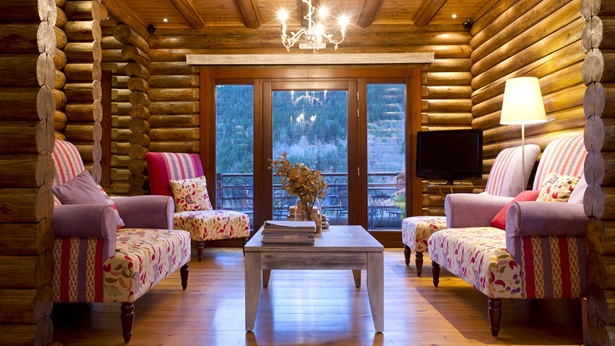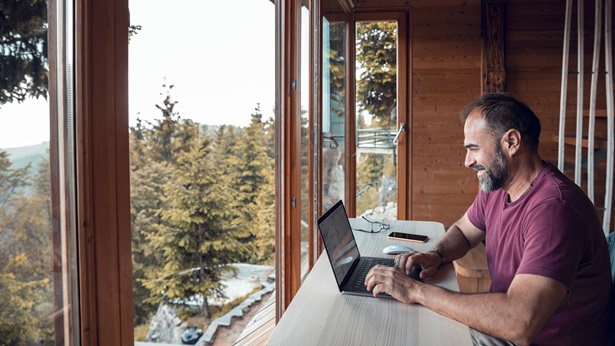How to Design a Cozy Log Cabin
11 Ways to Make the Most of Your Square Footage While Saving Money
Your new log and timber home doesn’t need to be sprawling in square footage to be unique. Indeed, a cozy log cabin has its own enduring charm. Whether it’s to be a weekend getaway or the home you plan on transitioning into retirement with, you want your new cabin to be designed to meet your long term needs.
Veteran log and timber home designers with the Log and Timber Homes Council suggest these 11 ways to make the most of your square footage.
- Start Shopping Smaller Designs
Peruse smaller square footage designs from companies that belong to the Log and Timber Homes Council. Many of these companies are keenly aware of the challenges facing buyers, so they’ve invested in creating smaller floor plans to meet different budgets and needs. These can be a jumping off point for your custom design, or you can save money by going with a standard plan. - Reduce or Eliminate Hallways
If you’ve got a custom design you’ve already invested time or money in, consider reducing or eliminate hallways. While a hallway is great for increasing privacy, its space is largely unused. Use your small rooms as passageways instead and gain the extra square footage. - Turn Up The Ceiling Volume
Standard wall height can be seven feet, six inches high. This was common in ‘70s era designs. However, one can increase the spacious feel of the interior by raising wall height to eight, nine or ten feet, which will make the interior appear much larger. Be aware that this can add to the cost of the log and timber home package, since it will require additional courses of logs. - Go with Cathedral Ceiling
Adding a cathedral ceiling or a smaller tray ceiling will also make the volume of the room seem greater. If you’re looking to reduce costs, consider using conventionally framed scissor trusses and drywall to construct your ceiling. This will create a cathedral ceiling at less cost than structural wood beams with tongue-and-groove paneling. What is the trade-off for this additional volume of space? It will increase your heating and cooling costs slightly. - Opt for Tall Windows
If want to add lots of natural daylight to make the room seem airy, opt for multiple windows that are tall with a thin width. This will give the illusion of height to the room without diminishing light the amount of light. - Organize Your Storage Space
Even though you’re opting for a smaller cabin design, you will still need a place for your stuff. That’s why designers say to organize your storage spaces by using pre-fab storage systems, which can accommodate twice as many items as the standard closet rod and shelf approach. Consider sliding doors on your closets, since they take up less space than bi-fold doors and cost less too. - Built-Ins are In
Built in bookcases, TV shelves and work spaces make a small room more useful, which will allow you to utilize a space better without defaulting to simply making the home larger. It’s also a great way to save money, using built-ins instead of furniture. - More Lighting
Since wood absorbs light instead of reflecting it like drywall does, include more lighting fixtures to make your cabin seem spacious. There are three basic types of lighting — general, task and accent — and your log cabin should include all three. Read more about log and timber home lighting strategies. - Specific Log Cabin Design Strategies
Mud Room: Use a bench in this rear foyer to facilitate removing muddy shoes. Lockers or cubbyholes can store briefcases, backpacks, mail, cell phone recharging center and key organizer.
Great Room: You can still make a small great room great by using skylights or solar tubes to bring in more natural daylight and draw the eye upward. Save square footage by using a gas hearth, which requires less space than a full masonry fireplace. Use built-ins under windows for storage and seating.
Spare Bedroom Double Duty: Looking to use a spare bedroom room as a home office or hobby area is as easy as outfitting it with a “Murphy bed,” one which folds up into the wall when not in use. Hidden home office systems, which also close up into the wall, provide the same flexibility for a spare bedroom.
Bathroom Needs: Separate baths for each of bedroom would be ideal. But the expense and space required can make it impractical. Compartmented baths are a welcome solution. But an emerging trend is to provide private ½ baths for each bedroom, leading to a common shower/tub area. - Get More Out of Your Garage
Since homeowners are paying for the garage, they reason they should get more out of it. Enter the garage as the flexible entertaining space for larger gatherings, such as high-school graduation parties or as a play area for the kids in inclement weather. Storage units can be used to keep everything organized, reducing clutter. - Keep It Flexible
Today the master suite has become multipurpose flex space in many new home designs. Homeowners can use it as a place to curl up with a book, an exercise area, sewing center or hobby area. It’s whatever makes the owners feel good. So borrow from this approach and use all the rooms in your floor plan for more than one purpose.



